44 Points and Three Mexican Waves
- Monday, October 31 2011 @ 10:27 pm ACDT
- Contributed by: Stephen Alomes
- Views: 4,438

International Rules has always been a clash of cultures, which I wrote about regarding the sporting exchange's first three decades (later republished on WFN). Old and new versions of cultural differences were on display at Docklands Stadium on Friday night.
Some past and present events might explain why the first of the two Tests (the second is at Carrara on the Gold Coast, aka Metricon Stadium, on Friday 4 November) resulted in a 44 point victory to Ireland in a one sided game and three Mexican waves from a crowd in search of entertainment.
In this opinion piece, I want to begin by considering the past. Australians have three misunderstandings about the series and its history over a quarter century since 1984 and over four decades since 1967.
First, they tend to assume the professional VFL/AFL players will be superior to the Irish amateurs, which is not true. In fact, most series have been won by the away team due to greater team bonding, team skill and application. The matches have often been exciting and passionate as when 1980s VFL President Allen Aylett was excited by this ‘space age football’.
Second, that as in the TV guide photo of a famous clash in the 2000s, inserted by the dumbest of sub-editors in search of a cheap melodramatic moment, they assume it is all about biffo. In fact, only on three occasions, in New York on the Galahs’ original world tour in the Sixties, in 1986, when Australia was coached by John Todd, and in a Melbourne clash in the 2005 have fights been central, on the last two occasions putting the game in jeopardy. (I discuss the cultural gap leading to physical conflict in A Meeting of Cultures.)
Third, there are the even dumber ex-players, journalists and MGPs (Members of the General Public) who are not interested themselves, see the game as a threat to the traditional game (Australian Football or Gaelic Football – it happens at both ends!) and assume the series is a joke. Some of the MGP, who we might call ‘Kevin Dumb of Beaumaris’, write idiot short letters to the papers every time there is a series, declaring how silly it all is, often repeating themselves in public with almost the same words. They leave a bad smell.
Some supporters of international footy are also not enthused. They see the series as a distraction or a competitor. In fact, they should reflect that the same negative attitudes towards International Rules by the small-minded cynics would be the attitude they would hold towards the development of world footy if they knew any more about it. Their attitude to anything which is not club or AFL is, like the pack mentality of some journalists, characterised by myopia.
In fact, the fifteen Irish-Australian series have been popular with attendances averaging around 70,000-80,000 total for the two tests in Australia and, especially with a Croke Park Dublin match, usually more in Ireland. They have also been close and exciting matches despite the two cultures of negativism, the Aussie one of ‘knockers’ and the Irish one of ‘begrudgery’.
The Australian matches also have a festival spirit. They particularly attract a younger audience, wearing shorts on warmer days, or clad in patriotic fancy dress (flags, coloured wigs, and more…from green and gold to greener than green) or even the Australian national team guernsey, which is the most brilliantly designed of any footy new jumper in the last half century. Friday night’s match was enhanced by the music of Mick Thomas (formerly Weddings Parties Anything) although the tape of the power and the passion which preceded the game seemed mainly to strike a chord only with the players in green.
The series has always had problems produced by distance and money, despite the fact it has always returned a profit, handsome at times, good at others. Distance means that each side knows too little, culturally or sportswise, about the other’s game, or its traditions or teams. Money means that it has be two, not three matches, which could lead to a natural decider rather than a points aggregate to determine the victor if it is one all. The Irish amateurs need to get back to work, especially given the calamitous state of the Irish economy, which means that keeping a job is even more important. The Australian professionals have too many ‘tidy up’ operations (a negative of the fully professional game; for example12 West Coast Eagles this year) or do not want to interrupt their short holidays before some clubs start training in November. Richmond begins on November 1 - on Cup Day!
As in the blight of European soccer, even if a player wants to put country before club, often their clubs do not feel the same way. In Ireland the reason is often local passion, and in the AFL it is also influenced by an economic view of the player’s worth to the club.
No sporting organisation orchestrates its events and manages its media presentation with the success of the AFL. Unfortunately, this was the exception. In 2011 the AFL did less marketing, unless I am mistaken. There were less big media events and seemingly no events using past players who loved the game (from Barassi and Skilton to Dipper Dipierdomenico to Jim Stynes and beyond) to market the series. There were some billboards, some radio ads on sports stations and shows, but the marketing seemed soft.
Nor was it a marketing coup to announce the 2012 fixture on the same day, while the Friday night of what has become a four day Melbourne Cup long weekend for many people did not help. Nor did the weather, evening thunderstorms, even though the game was played under the covered roof of Docklands stadium.
Nor did the AFL approach football preparation adequately. It selected a team of players with only four with previous experience. Were they given Gaelic balls to practise with in September or after the Grand Final? No, it would appear, and they had their first full training on the Sunday before the match the next Friday.
Strangely, in a kind of cultural transformation, the AFL which once selected mainly the All Australian Team players for the squad, went in the direction not only of novices but also of smaller players. The Irish, aware of the physicality and marking of the Australians, chose an unusually bigger and stronger side. Secondly, on the night the Australians rightly avoided succumbing to the crazy aggro of the low point moments of the past, but overcompensated by reduced tackling. At the same time, the Irish, given a stronger element from the AFL-based players, played a hard physical game as well as showing greater skill in ball control, ball movement and passing by hand and foot as well as goalkicking.
What was the result of all these on and off-field events, including, as Rohan Connolly pointed out in the Age and on 3AW, the negative accounts of a few scribes who did not like the game themselves and wanted to spoil other people’s pleasure? The result was an uneven contest which the Irish won by 44 points before a crowd of 22,921 on that wet night at Docklands.
After fifteen series, this is now a tradition, and one worth preserving, despite the drongos and nongs who knock it. On Friday night, the Irish won the applause of a slightly stunned pro-Aussie majority crowd, very different to the events of the next day in which Alan Joyce became the most unpopular Irishman in the whole country. May the Queensland match, in an even more challenging territory, not need a Mexican wave to enhance the festive fans’ pleasure.
Wearing the flag
Aussie colour confusions
Carn the Irish
Old and new colours
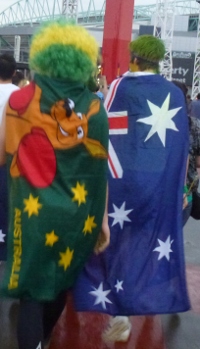
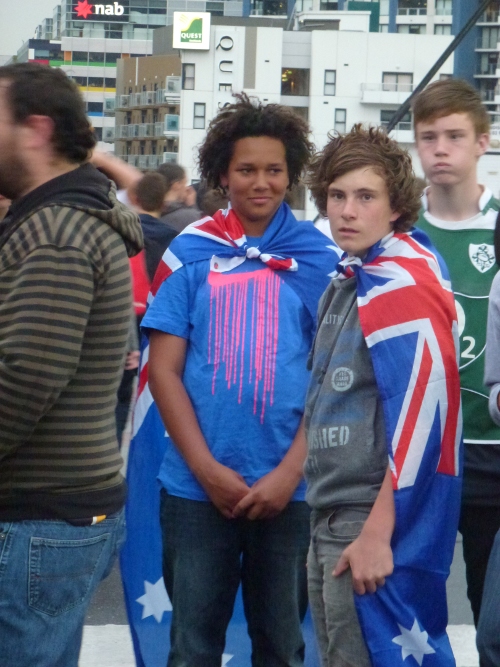
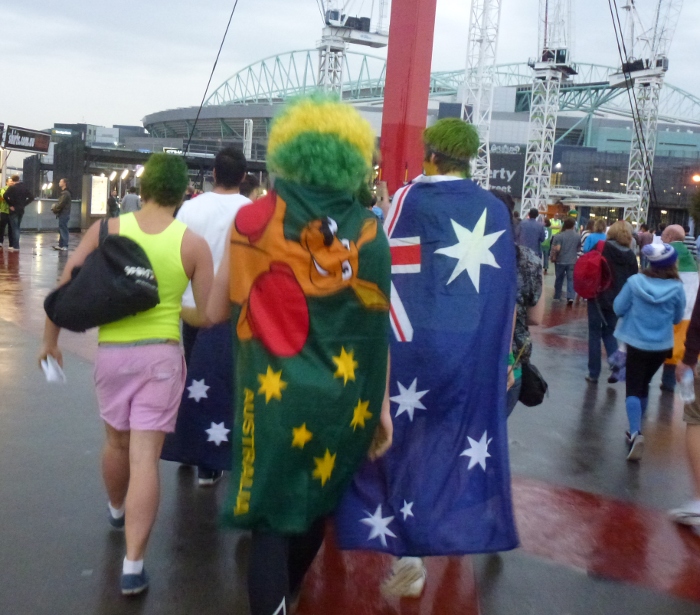
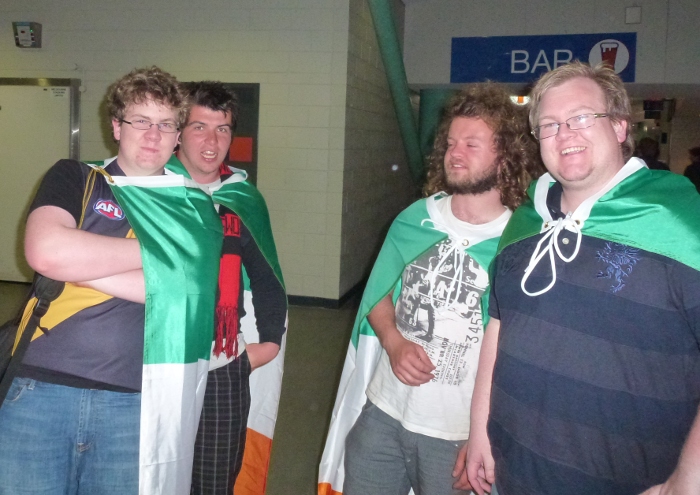
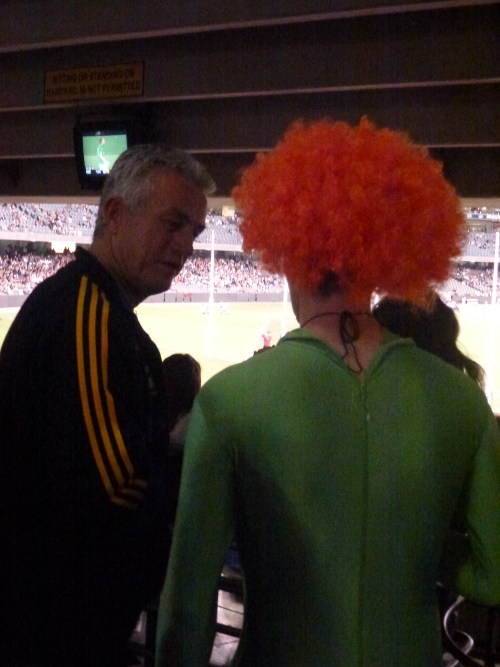


 RSS news
RSS news Twitter
Twitter Facebook
Facebook